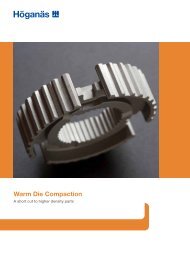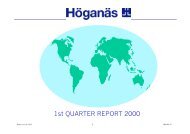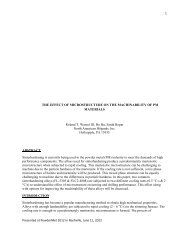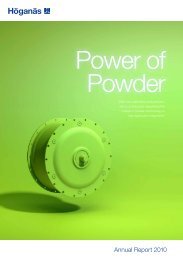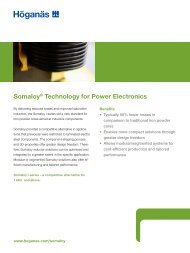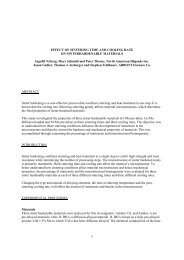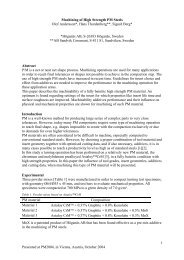high density pm components by high velocity ... - Höganäs AB
high density pm components by high velocity ... - Höganäs AB
high density pm components by high velocity ... - Höganäs AB
You also want an ePaper? Increase the reach of your titles
YUMPU automatically turns print PDFs into web optimized ePapers that Google loves.
quenching in oil and tempering at 180°C for 60 min in air. The case depth is 0.5 mm. A hardness profile<br />
and micrographs are presented in Figure 10.<br />
Figure 10. Micrograph and hardness profile for case-hardened test bar. Astaloy Mo+0.2%C @ 7.7g/cm3<br />
A surface hardness of 57 HRC or 790 HV10 was observed at the maximum <strong>density</strong>, 7.7g/cm 3 . The most<br />
striking effect can be seen in the bending fatigue limit that rises to at least 550 MPa. The level of bending<br />
fatigue performance achieved due to the <strong>high</strong> <strong>density</strong> and the case-hardening is of great interest since this<br />
property can be related to the root bending fatigue performance of a gear.<br />
Table 4. Properties of case-hardened Astaloy Mo + 0.2%C<br />
SD Hardness Tensile strength Yield strength Bending fatigue limit<br />
(g/cm 3 ) HV10 HRC (MPa) (ksi) (MPa) (ksi) (MPa) (ksi)<br />
HVC 7,54 730 54 960 134 720 100 Not tested<br />
HVC Double pressed 7,70 790 57 1040 145 805 112 +550* 76<br />
Sintering:1120 o C 30min 90%N2/10%H2; Case-hardened and tempered<br />
* Comment: Upper limit of the fatigue test equi<strong>pm</strong>ent was reached<br />
The relevance of tensile and yield strength values generated from case-hardened test bars can be<br />
questioned since they are not useful in component design. However, they indicate the degree of strength<br />
increase compared to an as-sintered material with the same or similar matrix. A tensile strength in the<br />
order of 1000 MPa was observed for the case-hardened samples.<br />
VII. DISCUSSION<br />
Develo<strong>pm</strong>ent of new <strong>high</strong>-<strong>density</strong> methods expands the potential of powder metallurgy <strong>by</strong> improved<br />
material performance. High Velocity Compacted PM materials can reach very <strong>high</strong> ultimate tensile<br />
strength in combination with <strong>high</strong> ductility. In the experiments described in this paper, tensile strength<br />
exceeding 1000 MPa and an elongation of approximately 5% have been recorded for a FN0206 material.<br />
The combination of <strong>high</strong> <strong>density</strong> and sinter-hardening has proven to offer significant improvement in<br />
mechanical properties. Faster cooling during sinter-hardening, preferably faster than 5 o C/s (10 o F/s) for<br />
production furnaces, would be advantageous since more of the potential of the <strong>high</strong>-<strong>density</strong> materials<br />
could then be utilized. Case-hardened <strong>high</strong>-<strong>density</strong> materials are very attractive for <strong>high</strong>-performing gears<br />
since the hardness and compressive stresses have a potential to significantly reduce flank wear and<br />
improve root bending fatigue performance to levels that can meet the requirements for proper function.<br />
10<br />
HV0,1<br />
Microhardness<br />
Astaloy Mo +0.2%C @ 7.7 g/cm 3 - case hardened<br />
1000<br />
900<br />
800<br />
700<br />
600<br />
500<br />
400<br />
300<br />
200<br />
100<br />
0<br />
0 0,5 1 1,5 2<br />
Distance from surface (mm)



